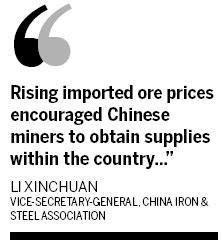 A total of 45 areas across the country have been selected as key mineral exploration sites, said Wang Min, vice-minister of land and resources.
A total of 45 areas across the country have been selected as key mineral exploration sites, said Wang Min, vice-minister of land and resources.
The areas, which will be explored over the next five years, are in the country's 19 metallogenic belts, Wang said at the 12th Annual China Mining Congress and Expo in Tianjin on Tuesday.
Wang said the government is expected to reveal the location of the sites within the next three years and complete the restructuring of the mineral industry within eight years.
From January to August, total investment in China's mining industry reached nearly 530 billion yuan ($80 billion), a year-on-year increase of more than 20 percent, while investment in oil and natural gas exploration increased significantly, he added.
Xu Yong, deputy director of the Chief Geoscientist Office of the China Geological Survey (CGS), said that the exploration and development of the 45 sites will be a major aspect of the 12th Five-Year Plan (2011-2015).
China will invest more than 6 billion yuan annually in the geological survey, Xu added.
The evaluation of the potential capacity of 12 important mineral resources in the country including manganese and tin will be finished before 2015, he said.
In the first three quarters, total investment in solid mineral exploration in China reached 27 billion yuan, an increase of around 20 percent year-on-year, covering more than 30,000 mineral exploration programs, according to the latest statistics from the Ministry of Land and Resources.
In the 12 years since the ministry launched its exploration of the country's mineral sources, more than 900 mineral sites have been detected, including 152 large-scale ones.
He added in the first four years of the ongoing 11th Five-Year Plan (2006-2010), national coal reserves grew 26 percent compared to the first four years of 10th Five-Year Plan (2001-2005), while copper reserves increased 19 percent and iron reserves rose 9 percent.
From January to September, the output of raw coal, iron and 10 nonferrous metals increased steadily with raw coal reaching more than 2.4 billion tons, an increase of 17.2 percent year-on-year and iron reaching 780 million tons, up 25.9 percent year-on-year, the statistics showed.
Domestic iron ore production increased 25.9 percent year-on-year to 780 million tons in the first three quarters, while iron ore imports dropped 2.5 percent to 458 million tons in the same period, according to the data.
"Rising imported ore prices encouraged Chinese miners to obtain supplies within the country, which is in line with the government's efforts to reduce dependence on costly ore imports and boost domestic supplies," said Li Xinchuan, vice-secretary-general of China Iron & Steel Association.
China has domestic ore reserves of 62.4 billion tons, but most mines have a low iron content, adding to the cost of mining and accounting for Chinese steelmakers' reliance on imports for 62.3 percent of their iron ore consumption last year.





